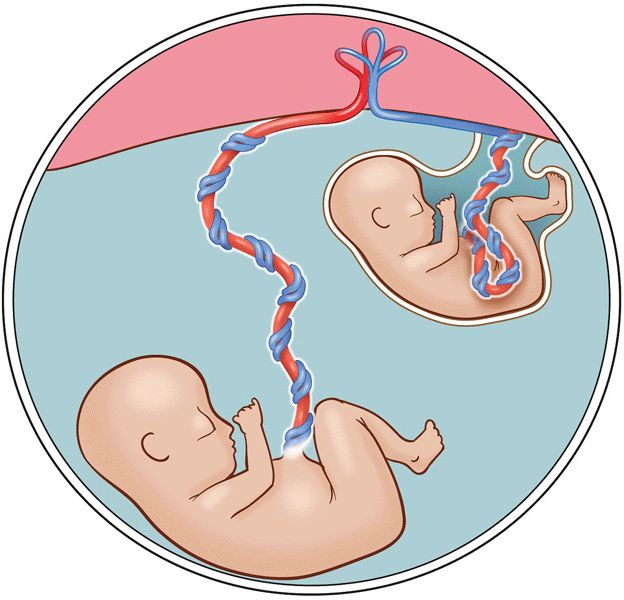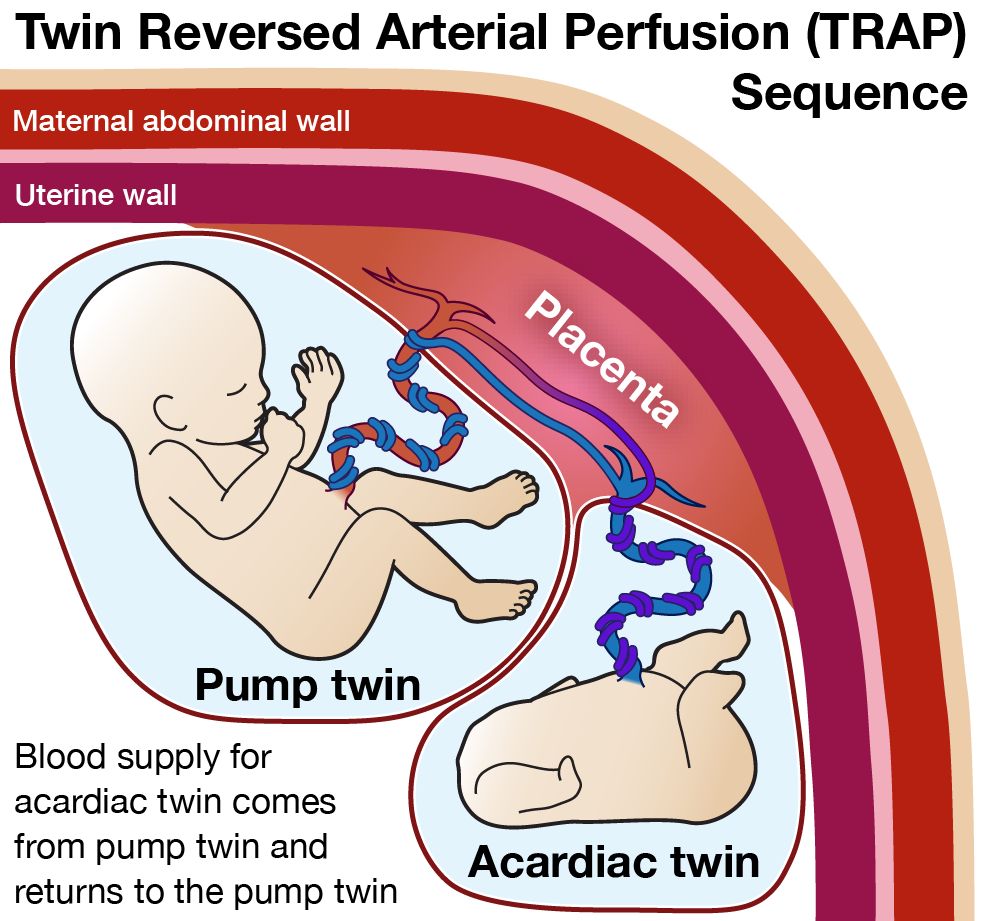Monochorionic Twins

A single placenta normally supports a single fetus. When the situation arises in which two fetuses have to share a single placenta, complications may sometimes develop. Identical twins that share a single placenta are called monochorionic twins (MC). “Chorion” is the Latin root that refers to the placenta, while the word “amnion” refers to the sac, or “membranes” that surround each fetus. While fraternal twins (2 eggs and 2 sperm) are always surrounded in their own sacs and have their own individual placentas, 70% of identical twins may end up sharing a single placenta. Only 1% of identical twins share both a single placenta and a single sac, and this poses significant risk.
When two fetuses share one placenta, their umbilical cords may implant anywhere – there is no set or predictable pattern – and depending on where they implant, one fetus may get less of a ‘share’ of the placenta than it’s co-twin, resulting in less blood flow and nutrition to one fetus, with more to the other (unequal placental sharing). As a result, although identical twins usually share the same genetic material, they may actually grow differently. Like the roots of a tree, the blood vessels that run from each implanted cord may connect with each other beneath the surface, as there is nothing separating them within a single placenta. Depending on which types of vessels connect to which, one fetus may transfuse blood to the other. We will discuss each of these complications, their risks, and potential treatments, below.
View our Monochorionic Twin Recommendations.
What is Twin to Twin Transfusion Syndrome (TTTS)?

Because there is no barrier separating the two fetuses from each other, there are almost always blood vessel connections in the placenta shared by two fetuses in MC pregnancies. As a result of these connections, in about 10-15% of monochorionic twins (sharing one placenta) an imbalance in the circulations of the fetuses can develop. In these instances, there may be significant transfer of blood from one twin (the so-called “donor”) to the other twin (the so-called “recipient”), resulting in twin-to-twin transfusion syndrome (TTTS).
Learn more about Twin to Twin Transfusion Syndrome (TTTS)
What is unequal placental sharing?
Although Twin-Twin Transfusion Syndrome (TTTS) is one of the most common diagnoses made in MC twins, not all MC twin pregnancies in which there are unequal fluid levels or a difference in size of the twins have TTTS. These findings can also be seen in a condition called “unequal placental sharing”. When two fetuses share one placenta, their umbilical cords may implant anywhere – there is no set or predictable pattern – and depending on where they implant, one fetus may get less of a ‘share’ of the placenta than it’s co-twin, resulting in less blood flow and nutrition to one fetus, with more to the other; aka, unequal placental sharings.
Learn more about unequal placental sharing
What is an acardiac twin or the TRAP sequence?

Twin reversed arterial perfusion (TRAP) sequence or acardiac twinning is a very rare problem, occurring in approximately 1% of monochorionic twin (twins sharing one placenta). One twin is usually structurally completely normal. The other is an abnormal mass of tissue, consisting usually of legs and a lower body, but no upper body, head or heart. Because of the absent heart, the term “acardiac twin” was been used to describe this mass. The normal fetus is referred to as the “pump twin” because its heart is used to pump blood to the abnormal mass. The “acardiac twin” has no chance of survival.
Due to the absence of a beating heart, the acardiac does not send blood to any portion of the placenta, and all of its blood supply comes from and goes back to the circulation of the pump twin through unique vascular connections on the surface of the shared placenta. Arteries usually carry blood away from the fetus and toward the placenta to receive oxygen from the mother’s circulation. When there is an “acardiac twin”, the unique vascular connections allow blood in the artery to flow in the reversed direction (toward the acardiac fetus rather than away from it). Thus, the phrase “twin reversed arterial perfusion” (TRAP) sequence has been used to describe this condition.
Learn more about Acardic Twin or TRAP sequence
Support Groups & Other Resources
- San Francisco Parents of Multiples Club — a network of parents and expectant parents of multiples that provides its members and their families with friendship, support and information on parenting twins, triplets and quads.
- The Fetal Hope Foundation — provides support and information to parents, funds research, and increases awareness about TTTS, TRAP Sequence, Amniotic Band Syndrome, and Urinary Tract Obstruction.
- TTTS Foundation — solely dedicated to providing immediate and lifesaving educational, emotional and financial support to families, MDcal professionals, and other caregivers before, during, and after a diagnosis of twin to twin transfusion syndrome.
- March of Dimes — Researchers, volunteers, educators, outreach workers and advocates working together to give all babies a fighting chance
- Birth Defect Research for Children — a parent networking service that connects families who have children with the same birth defects
- Kids Health — doctor-approved health information about children from before birth through adolescence
- CDC - Birth Defects — Dept. of Health & Human Services, Centers for Disease Control and Prevention
- NIH - Office of Rare Diseases — National Inst. of Health - Office of Rare Diseases
- North American Fetal Therapy Network — NAFTNet (the North American Fetal Therapy Network) is a voluntary association of medical centers in the United States and Canada with established expertise in fetal surgery and other forms of multidisciplinary care for complex disorders of the fetus.